Assessing the Cross-Sectoral Economic–Energy–Environmental Impacts of Electric-Vehicle Promotion in Taiwan
Abstract
:1. Introduction
2. Literature Review
2.1. Applying I–O Models to the Transportation Sector in Taiwan
2.2. Applying I–O Models to the EV Industry
2.3. Extended Application of I–O Models
3. Methods
- Single product: Each industry produces only one product. Two or more products produced at the same time are classified as main products.
- Constant returns to scale: The input–output ratio (the technical coefficient) is fixed—i.e., it is unaffected by the level of production.
- Fixed input structure: There is no input substitution in the production of any single commodity, which means that the same recipe of inputs will always be irreplaceability.
3.1. Principle of the I–O Method and Data Processing
F = X − AX,
F = (I − A)X,
(I − A)−1F = X
3.2. Scenario Setting
3.3. Learning Curve
3.4. Principle of Energy and Environmental Impacts and Data Processing
3.5. Equations of Production and Usage Impacts
4. Results and Discussion
4.1. Economic Impacts
4.2. Impact of EVs on Energy Consumption
4.3. Environment Impacts
4.4. Economic–Energy–Environmental Impacts
- As an emerging industry, there is a lack of available data on the manufacture of EVs in Taiwan. Thus, in the current study, we were limited to the work of Suehiro and Purwanto [16] as data sources for the input structure. Until data pertaining to the domestic EV market become available, it will not be possible to derive specific input structures for Taiwan.
- An inherent limitation of the I–O method is its dependence on the selection of coefficients (e.g., the income coefficient). It is important to consider that these coefficients are static; i.e., they cannot account for import substitution, technological improvements, or relative changes in input prices over time. In the future, it should be possible to integrate the I–O model with an econometric model to reflect the dynamic nature of these effects.
- Capturing the distribution and flow of products among different industries in a given year through the construction of I–O tables takes a great deal of time. The latest I–O table (for 2016) was released in 2021. The inputs will need to be updated upon the release of the next I–O table.
- We were unable to obtain data pertaining to average vehicle performance in Taiwan; therefore, we adopted the most popular models as representative of overall vehicle performance. Note, also, that the technological improvements affecting energy efficiency were not considered in this study. These issues could be considered in future studies.
5. Conclusions and Policy Implications
- Strengthen the EV usage environment: Despite the seemingly inevitable widespread adoption of EVs, many consumers remain skeptical. Governments should proactively develop the infrastructure required for fast-charging systems in residences, companies, and public parking lots. Governments should also continue the provision of purchase subsidies to bolster the market shares of BEVs and PHEVs. For example, the Clean Vehicle Assistance Program (under Advanced Clean Cars II) in California provides low-income car buyers with down-payment subsidies of up to USD 5000 and favorable loan-interest rates. This program is backed by Governor Newsom’s USD $2.4 billion investment in vehicle incentives, the charging infrastructure, and public outreach programs.
- Promote the development and manufacture of EVs in Taiwan: The bourgeoning EV industry has enormous economic potential, particularly in terms of EV components, batteries, and the charging infrastructure. At present, Taiwan relies almost exclusively on imported EV batteries. Retaining the benefits of this transition will require Taiwan to develop domestic EV-battery technology. Therefore, we recommend that governments assist the domestic automobile industry in expanding production capacity. It is also expected that EV development will have a profound impact on the ICEV industry. Therefore, we recommend that governments enhance the resilience of domestic manufacturers by providing technical and financial support to promote the transformation of ICEVs. As an example, consider the subsidies for the EV industry in Austria. The Austrian Research Promotion Agency provides a 14% research tax credit to companies that are engaged in the technology development of EVs. The Austrian government has also established a “Climate and Energy Fund”, which provides financial support (grants of EUR 30,000 to EUR 750,000) to companies engaged in environmental and energy research.
- Strengthen the power supply and grid: A transition to EVs will inevitably increase demand for electricity and peak load levels, with a corresponding increase in pollution emissions. Governments should schedule the construction of new power-generation facilities and the decommissioning of outdated systems, as well as conduct rolling adjustments to compensate suppliers for changes in the demand for power. It is also important to continue the development of renewable energy to reduce emissions. One approach to overcoming the problem of peak load is to establish a payment mechanism aimed at spreading out the temporal distribution of EV-charging-station usage. Governments should also seek to strengthen energy-storage systems and vehicles-to-grid (V2G) technology to enhance the stability of the power grid.
Author Contributions
Funding
Institutional Review Board Statement
Informed Consent Statement
Data Availability Statement
Conflicts of Interest
References
- REN21. Renewables 2023 Global Status Report. Available online: https://www.ren21.net/gsr-2023/ (accessed on 1 September 2023).
- IEA. Global EV Outlook 2023. Available online: https://www.iea.org/reports/global-ev-outlook-2023 (accessed on 1 September 2023).
- National Development Council. Taiwan’s Pathway to Net-Zero Emissions in 2050. Available online: https://www.ndc.gov.tw/en/Content_List.aspx?n=B154724D802DC488 (accessed on 31 December 2022).
- Yang, L.; Yu, B.; Yang, B.; Chen, H.; Malima, G.; Wei, Y.M. Life cycle environmental assessment of electric and internal combustion engine vehicles in China. J. Clean. Prod. 2021, 285, 124899. [Google Scholar] [CrossRef]
- Hussain, A.; Ullah, K.; Senapati, T.; Moslem, S. Complex spherical fuzzy Aczel Alsina aggregation operators and their application in assessment of electric cars. Heliyon 2023, 9, e18100. [Google Scholar] [CrossRef]
- Mauler, L.; Duffner, F.; Zeier, W.G.; Lekerad, J. Battery cost forecasting: A review of methods and results with an outlook to 2050. Energy Environ. Sci. 2021, 14, 4712–4739. [Google Scholar] [CrossRef]
- Leontief, W.W. Quantitative input and output relations in the economic systems of the United States. Rev. Econ. Stat. 1936, 18, 105–125. [Google Scholar] [CrossRef]
- Lian, Y.W. Research on input-output analysis of transportation industry in Taiwan. Bank Taiwan Q. 1986, 37, 144–185. [Google Scholar]
- Wang, T.F. Economic effect analysis of Taiwan’s transportation and communication construction. Taipei Econ. Inq. 1990, 30, 79–125. [Google Scholar]
- Nir, A.S.; Liang, G.S. Transport sector construction inter-industry effects positive study in Taiwan area. Marit. Res. J. 2003, 14, 1–28. [Google Scholar]
- Chen, H.C. Analysis of the Influence on Economy of Kaohsiung Metropolis Caused by the Constructure of Mass Rapid Transmit. Master’s Thesis, Institute of Economics, National Sun Yat-sen University, Kaohsiung City, Taiwan, 2004. [Google Scholar]
- Lin, G.Y. The Initially Researches to Economic Activity and the Mobility Behavior of Passengers in Taiwan during High Speed Rail (HSR) Construction and Transport. Master’s Thesis, Institute of Public Affairs Management, National Sun Yat-sen University, Kaohsiung City, Taiwan, 2011. [Google Scholar]
- Mead, D. The impact of the electric car on the U.S. economy: 1998–2005. Econ. Syst. Res. 1995, 7, 413–438. [Google Scholar] [CrossRef]
- Leurent, F.; Windisch, E. Benefits and costs of electric vehicles for the public finances: An integrated valuation model based on input-output analysis, with application to France. Res. Transp. Econ. 2015, 50, 51–62. [Google Scholar] [CrossRef]
- Ulrich, P.; Lehr, U. Economic effects of an e-mobility scenario—input structure and energy consumption. Econ. Syst. Res. 2020, 32, 84–97. [Google Scholar] [CrossRef]
- Suehiro, S.; Purwanto, A.J. The Influence on Energy and the Economy of Electrified Vehicles Penetration in ASEAN; ERIA Research Project Report 2020, No. 14; ERIA: Jakarta, Indonesia, 2020. [Google Scholar]
- Nagashimaa, S.; Uchiyamaa, Y.; Okajima, K. Environment, energy and economic analysis of wind power generation system installation with input-output table. Energy Procedia 2015, 75, 683–690. [Google Scholar] [CrossRef]
- Hienuki, S.; Kudoh, Y.; Hondo, H. Life cycle employment effect of geothermal power generation using an extended input-output model: The case of Japan. J. Clean. Prod. 2015, 93, 203–212. [Google Scholar] [CrossRef]
- Varela-Vazquez, P.; Sanchez-Carreira, M.C. Estimation of the potential effects of offshore wind on the Spanish economy. Renew. Energy 2017, 111, 815–824. [Google Scholar] [CrossRef]
- Nakanoa, S.; Araib, S.; Washizuc, A. Development and application of an inter-regional input-output table for analysis of a next generation energy system. Renew. Sustain. Energy Rev. 2018, 82, 2834–2842. [Google Scholar] [CrossRef]
- Bekel, K.; Pauliuk, S. Prospective cost and environmental impact assessment of battery and fuel cell electric vehicles in Germany. Int. J. Life Cycle Assess. 2019, 24, 2220–2237. [Google Scholar] [CrossRef]
- Lombardi, L.; Tribioli, L.; Cozzolino, R.; Bella, G. Comparative environmental assessment of conventional, electric, hybrid, and fuel cell powertrains based on LCA. Int. J. Life Cycle Assess. 2017, 22, 1989–2006. [Google Scholar] [CrossRef]
- Yan, X.; Sun, S. Impact of electric vehicle development on China’s energy consumption and greenhouse gas emissions. Clean Technol. Environ. Policy 2021, 23, 2909–2925. [Google Scholar] [CrossRef]
- Das, J. Comparative life cycle GHG emission analysis of conventional and electric vehicles in India. Environ. Dev. Sustain. 2022, 24, 13294–13333. [Google Scholar] [CrossRef]
- Hofmann, J.; Guan, D.; Chalvatzis, K.; Huo, H. Assessment of electrical vehicles as a successful driver for reducing CO2 emissions in China. Appl. Energy 2016, 184, 995–1003. [Google Scholar] [CrossRef]
- Liu, D.; Xu, L.; Sadia, U.H.; Wang, H. Evaluating the CO2 emission reduction effect of China’s battery electric vehicle promotion efforts. Atmos. Pollut. Res. 2021, 12, 101115. [Google Scholar] [CrossRef]
- Winyuchakrit, P.; Sukamongkol, Y.; Limmeechokchai, B. Do electric vehicles really reduce GHG emissions in Thailand? Energy Procedia 2017, 138, 348–353. [Google Scholar] [CrossRef]
- Directorate General of Budget, Accounting and Statistics, Executive Yuan. The Report on 2016 Input-Output Statistics; Executive Yuan: Taipei, Taiwan, 2020. [Google Scholar]
- IEA. Global EV Outlook 2022. Available online: https://www.iea.org/reports/global-ev-outlook-2022 (accessed on 31 January 2023).
- Wright, T.P. Factors affecting the cost of airplanes. J. Aeronaut. Sci. 1936, 3, 122–128. [Google Scholar] [CrossRef]
- Weiss, M.; Patel, M.K.; Junginger, M.; Perujo, A.; Bonnel, P.; Grootveld, G. On the electrification of road transport-Learning rates and price forecasts for hybrid-electric and battery-electric vehicles. Energy Policy 2012, 48, 374–393. [Google Scholar] [CrossRef]
- Weiss, M.; Zerfass, A.; Helmers, E. Fully electric and plug-in hybrid cars—An analysis of learning rates, user costs, and costs for mitigating CO2 and air pollutant emissions. J. Clean. Prod. 2019, 212, 1478–1489. [Google Scholar] [CrossRef]
- Bureau of Energy BOE. Energy Statistics Handbook 2019; Bureau of Energy, Ministry of Economic Affairs: Taipei, Taiwan, 2019. [Google Scholar]
- Kim, H.C.; Wallington, T.J.; Mueller, S.A.; Bras, B.; Guldberg, T.; Tejada, F. Life cycle water use of ford focus gasoline and ford focus electric vehicles. J. Ind. Ecol. 2015, 20, 1122–1133. [Google Scholar] [CrossRef]
- Bureau of Energy BOE. 2020 Vehicle Fuel Economy Guide; Bureau of Energy, Ministry of Economic Affairs: Taipei, Taiwan, 2021. [Google Scholar]
- Environmental Protection Agency. Taiwan Emission Data System; Environmental Protection Agency: Taipei, Taiwan, 2021. [Google Scholar]
- IQAir. 2022 World Air Quality Report. 2022. Available online: https://www.iqair.com/us/world-air-quality-report#msdynttrid=BScYH7jfCKlFL5Cb54-VR2LvdUe3v8vK_IbtpA5mzLY (accessed on 1 September 2023).
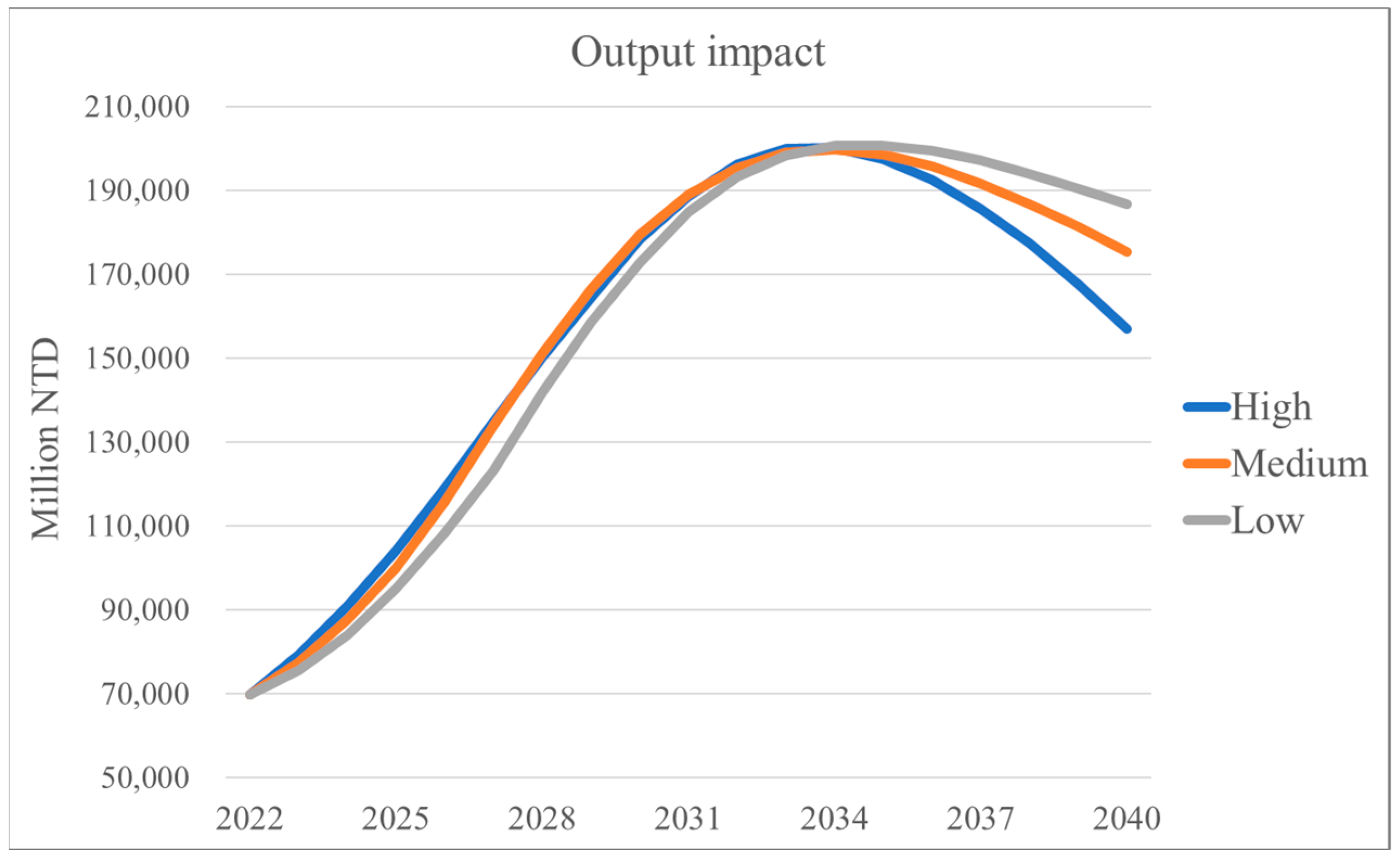
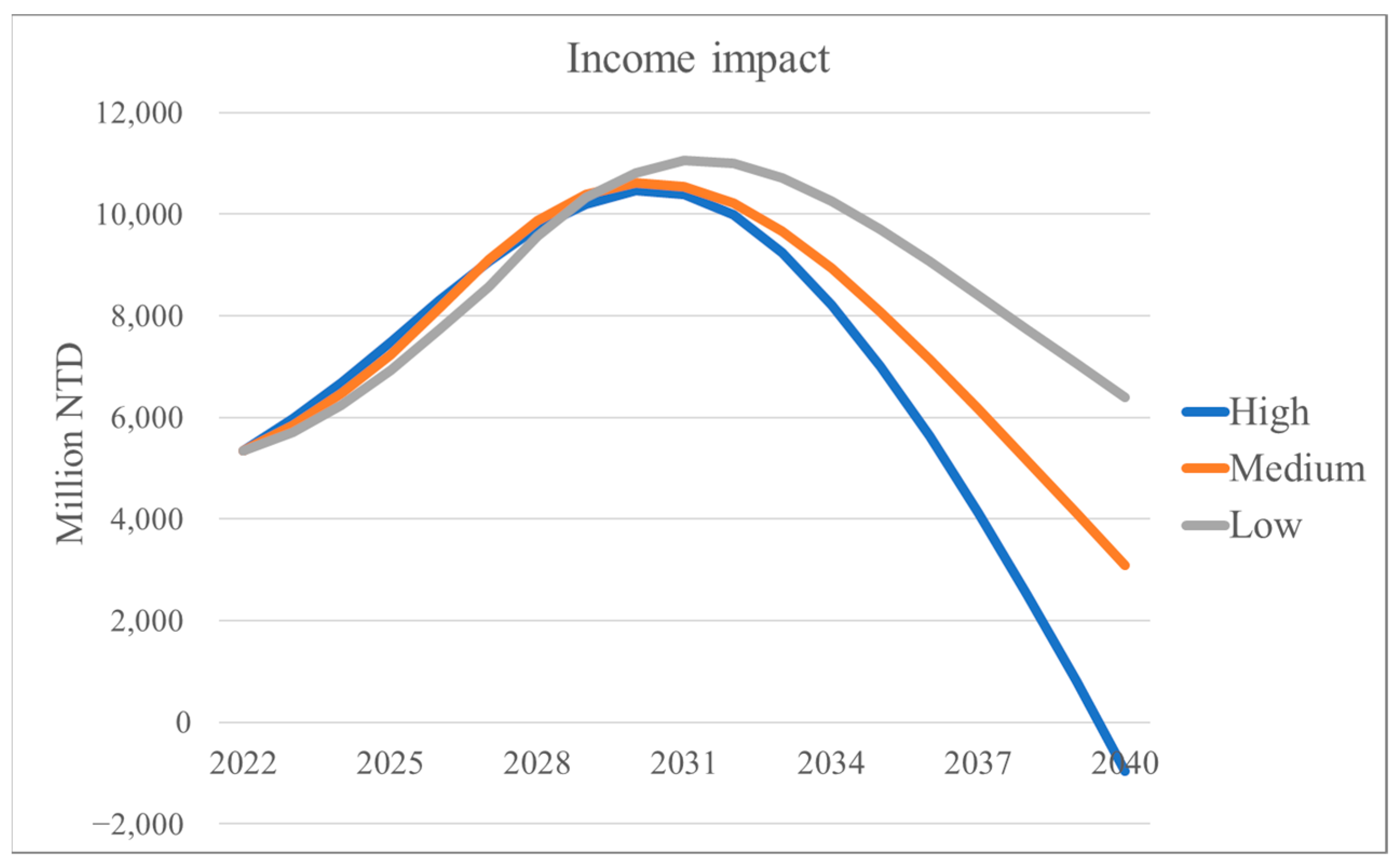



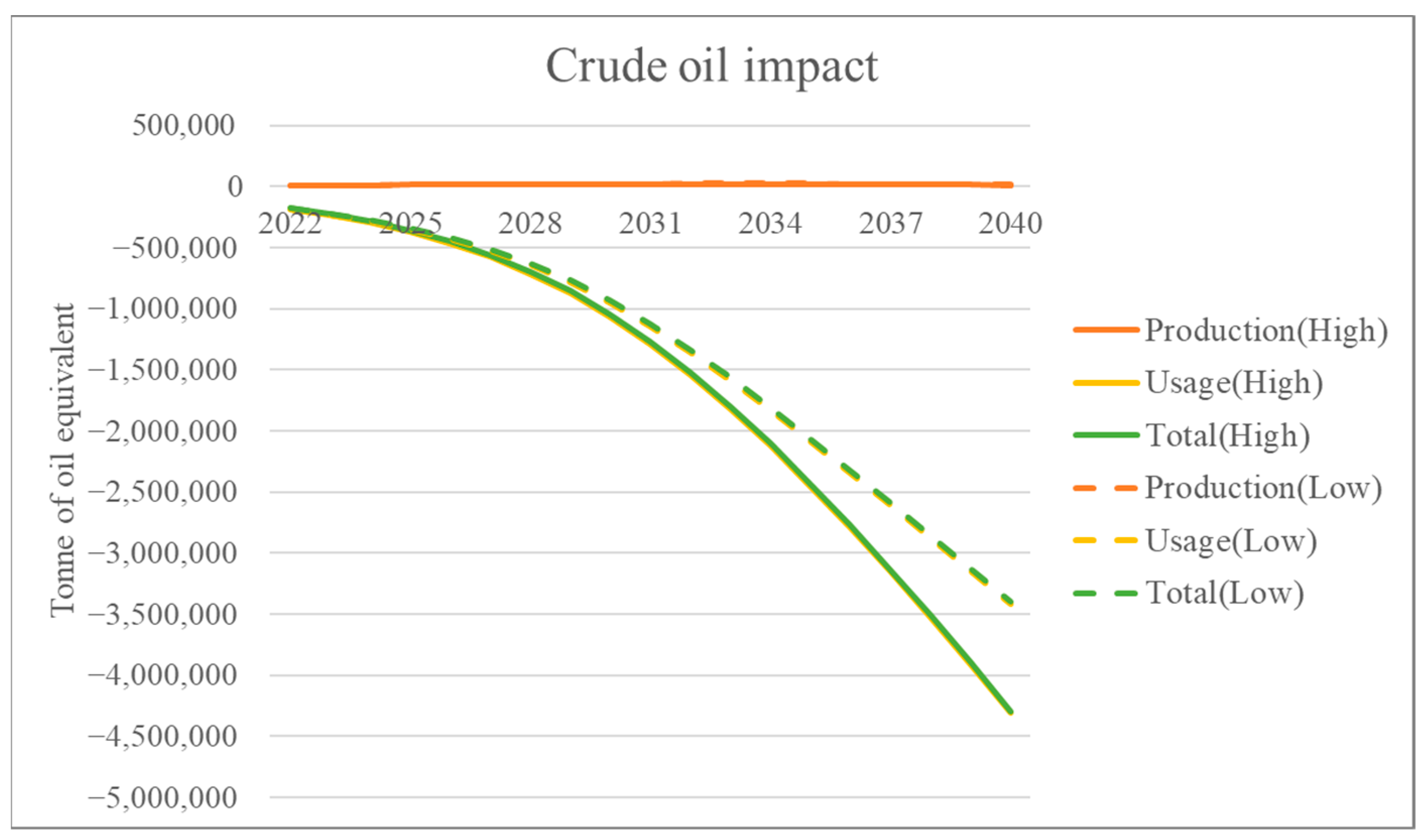
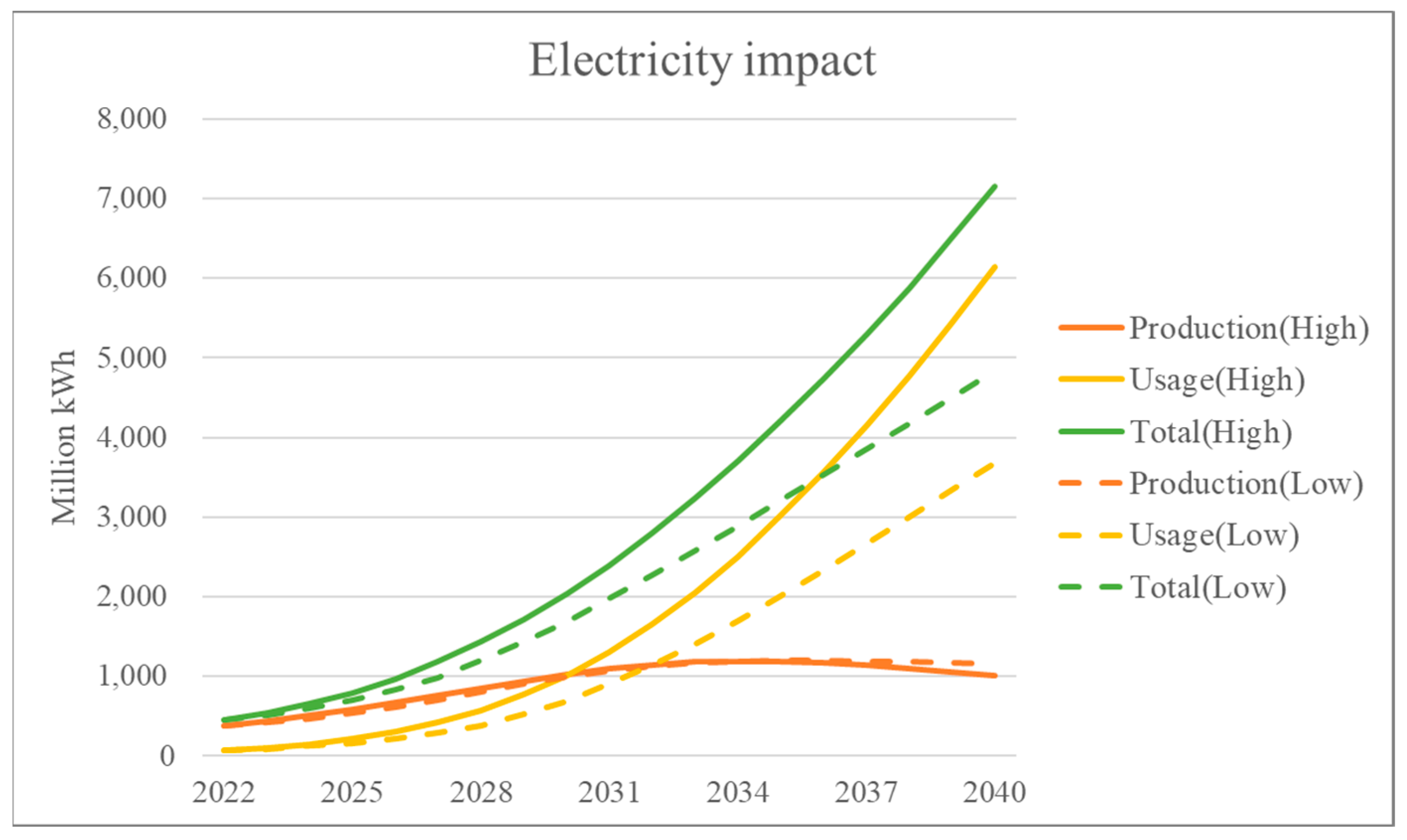
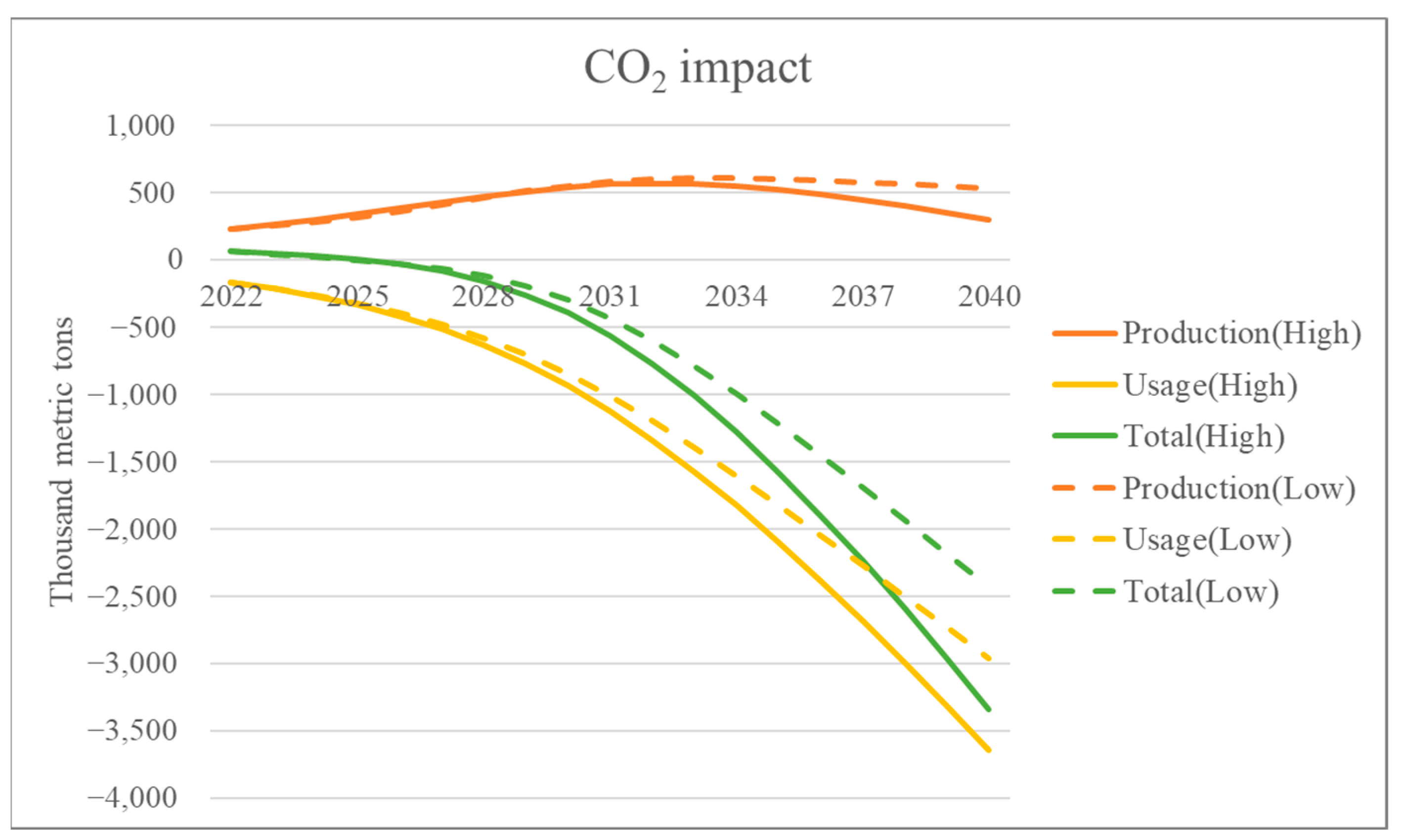


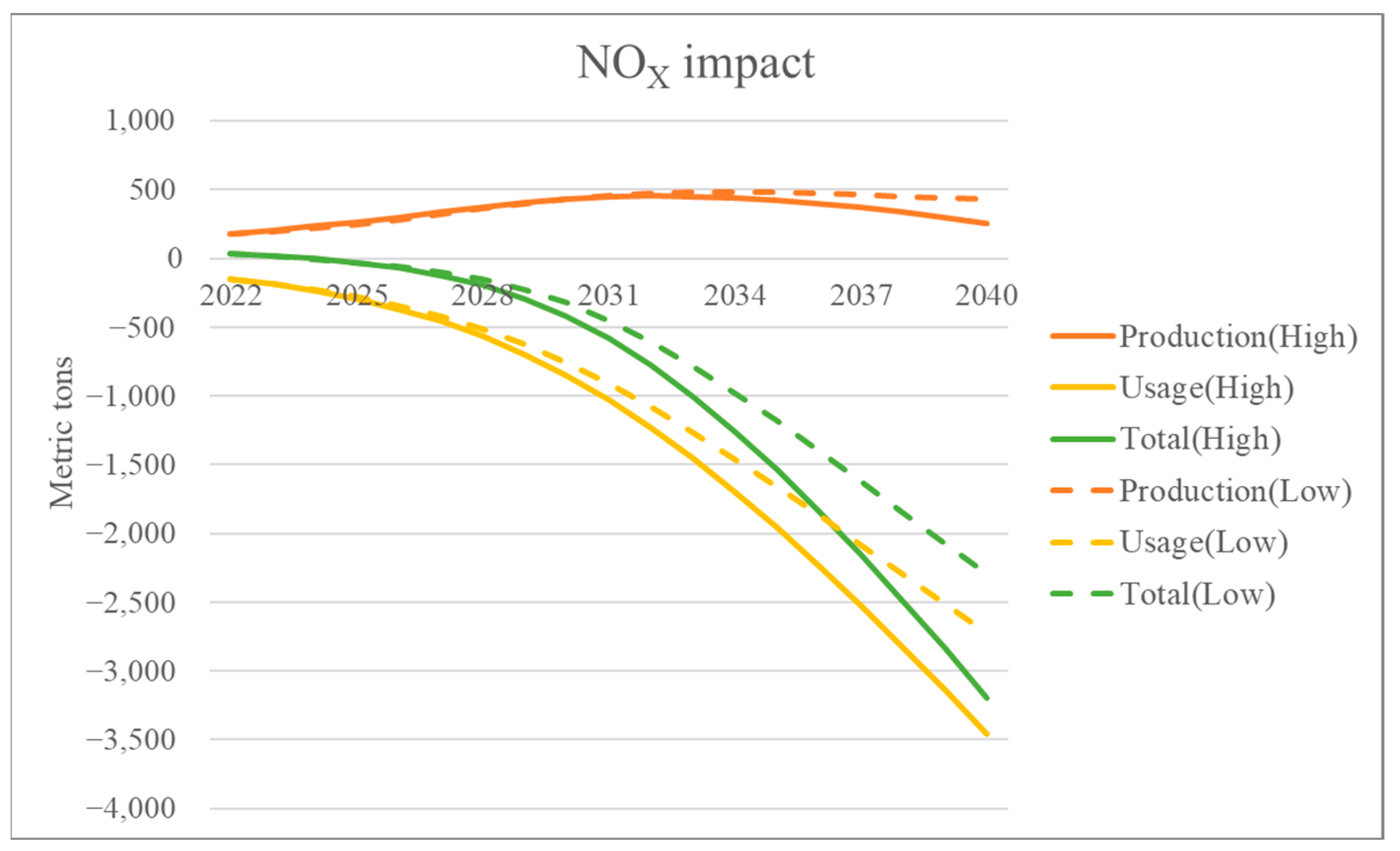

| Industry | ICEV | HEV | PHEV | BEV |
|---|---|---|---|---|
| Chemicals, rubber, plastic | 4.68% | 3.80% | 3.12% | 2.98% |
| Metal and metalworking | 10.49% | 8.50% | 6.99% | 6.67% |
| Electronic components | 1.44% | 2.04% | 2.25% | 1.83% |
| Electronic equipment | 2.34% | 13.14% | 15.96% | 23.60% |
| Machinery | 1.54% | 1.25% | 1.03% | 0.98% |
| Manufacture of ICEV | 38.36% | 14.55% | 11.84% | 0.00% |
| Wholesale and retail | 8.37% | 6.94% | 5.69% | 5.26% |
| Services | 3.03% | 2.51% | 2.06% | 1.90% |
| EV industry | 0.00% | 17.09% | 13.80% | 13.15% |
| Other intermediate input | 3.44% | 2.81% | 2.31% | 2.18% |
| Total intermediate input | 73.69% | 72.61% | 65.05% | 58.56% |
| Compensation of employees | 8.19% | 6.54% | 5.35% | 5.11% |
| Operating surplus | 8.13% | 10.86% | 19.60% | 26.34% |
| Other value-added | 10.00% | 10.00% | 10.00% | 10.00% |
| Total value-added | 26.31% | 27.39% | 34.95% | 41.44% |
| Total input | 100.00% | 100.00% | 100.00% | 100.00% |
| Scenario | Year | HEV | PHEV | BEV | PHEV + BEV | Total |
|---|---|---|---|---|---|---|
| Low | 2025 | 22.84% | 0.57% | 4.29% | 4.86% | 27.70% |
| 2030 | 37.50% | 2.54% | 18.46% | 21.00% | 58.50% | |
| 2035 | 45.15% | 4.74% | 36.55% | 41.29% | 86.44% | |
| 2040 | 48.16% | 5.76% | 46.08% | 51.84% | 100.00% | |
| Medium | 2025 | 21.35% | 0.75% | 5.60% | 6.35% | 27.70% |
| 2030 | 28.98% | 3.56% | 25.96% | 29.52% | 58.50% | |
| 2035 | 30.10% | 6.46% | 49.88% | 56.34% | 86.44% | |
| 2040 | 24.08% | 8.44% | 67.49% | 75.92% | 100.00% | |
| High | 2025 | 19.86% | 0.92% | 6.92% | 7.84% | 27.70% |
| 2030 | 28.50% | 3.62% | 26.38% | 30.00% | 58.50% | |
| 2035 | 20.07% | 7.62% | 58.76% | 66.37% | 86.44% | |
| 2040 | 0.00% | 11.11% | 88.89% | 100.00% | 100.00% |
| Type | HEV | PHEV | BEV |
|---|---|---|---|
| Model | TOYOTA Corolla Altis Hybrid | Volvo XC60 T8 | Tesla Model 3 |
| Unit price in 2021 (P0) | NTD 887,000 1 | NTD 2,934,000 | NTD 1,813,900 |
| Cumulative production in 2021 (x0) | 223,921 | 2243 | 19,080 |
| Learning rate (R) | 7% | 14.9% | 11.5% |
| ICEV | HEV | PHEV (Gasoline) | PHEV (Electricity) | BEV | Unit | |
|---|---|---|---|---|---|---|
| Annual mileage | 15,000 | 15,000 | 5396 | 9604 | 15,000 | km |
| Energy efficiency | 14.9 | 24.1 | 17.1 | 52.2 (5.8) | 60.8 (6.7) | km/L, (km/kWh) 1 |
| Annual energy consumption | 1007 | 622 | 315 | 184 (1670) | 247 (2239) | L/year, (kWh/year) |
| Unit energy expenditure | 28.64 | 5 | NTD/L, NTD/kWh | |||
| Annual energy expenditure | 28,832 | 17,826 | 17,377 | 11,194 | NTD/year | |
| HEV | PHEV | BEV | Unit | |
|---|---|---|---|---|
| Crude oil | −0.52 | −0.93 | −1.36 | TOE/year |
| Electricity | 0 | 1.67 | 2.24 | MWh/year |
| CO2 | −0.49 | −0.68 | −1.14 | metric ton/year |
| PM2.5 | −0.03 | 0.01 | −0.01 | kg/year |
| SOx | −0.21 | 0.19 | 0.02 | |
| NOx | −0.41 | −0.48 | −1.13 |
| Industry | Output | Rank | Income | Rank | Employment | Rank |
|---|---|---|---|---|---|---|
| Farming and Agri-food | 1.86 | 10 | 0.35 | 7 | 0.84 | 2 |
| Textile | 1.95 | 6 | 0.37 | 5 | 0.61 | 3 |
| Wood and Paper | 1.81 | 13 | 0.33 | 11 | 0.53 | 6 |
| Chemicals, Rubber, Plastic | 1.90 | 8 | 0.22 | 15 | 0.28 | 18 |
| Mineral Products | 1.84 | 11 | 0.35 | 6 | 0.46 | 10 |
| Metal and Metalworking | 2.03 | 4 | 0.31 | 12 | 0.46 | 11 |
| Electronic Components | 1.50 | 14 | 0.18 | 19 | 0.26 | 19 |
| Electronic Equipment | 1.34 | 19 | 0.13 | 21 | 0.19 | 21 |
| Machinery | 1.87 | 9 | 0.33 | 10 | 0.49 | 8 |
| Manufacture of ICEV | 1.84 | 12 | 0.27 | 13 | 0.40 | 14 |
| Manufacture of Other Transportation | 2.01 | 5 | 0.34 | 8 | 0.46 | 12 |
| Other Manufacturing | 1.47 | 16 | 0.20 | 17 | 0.32 | 17 |
| Electricity, Gas, Water | 1.42 | 18 | 0.19 | 18 | 0.21 | 20 |
| Construction | 2.08 | 3 | 0.43 | 4 | 0.92 | 1 |
| Wholesale and Retail | 1.33 | 20 | 0.50 | 2 | 0.53 | 5 |
| Transportation | 1.49 | 15 | 0.34 | 9 | 0.52 | 7 |
| Services | 1.45 | 17 | 0.48 | 3 | 0.57 | 4 |
| Administration | 1.29 | 21 | 0.56 | 1 | 0.35 | 16 |
| HEV | 2.31 | 1 | 0.27 | 14 | 0.48 | 9 |
| PHEV | 2.12 | 2 | 0.22 | 16 | 0.43 | 13 |
| BEV | 1.94 | 7 | 0.18 | 20 | 0.37 | 15 |
Disclaimer/Publisher’s Note: The statements, opinions and data contained in all publications are solely those of the individual author(s) and contributor(s) and not of MDPI and/or the editor(s). MDPI and/or the editor(s) disclaim responsibility for any injury to people or property resulting from any ideas, methods, instructions or products referred to in the content. |
© 2023 by the authors. Licensee MDPI, Basel, Switzerland. This article is an open access article distributed under the terms and conditions of the Creative Commons Attribution (CC BY) license (https://creativecommons.org/licenses/by/4.0/).
Share and Cite
Chen, C.-H.; Huang, Y.-H.; Wu, J.-H.; Lin, H. Assessing the Cross-Sectoral Economic–Energy–Environmental Impacts of Electric-Vehicle Promotion in Taiwan. Sustainability 2023, 15, 14135. https://doi.org/10.3390/su151914135
Chen C-H, Huang Y-H, Wu J-H, Lin H. Assessing the Cross-Sectoral Economic–Energy–Environmental Impacts of Electric-Vehicle Promotion in Taiwan. Sustainability. 2023; 15(19):14135. https://doi.org/10.3390/su151914135
Chicago/Turabian StyleChen, Chi-Hao, Yun-Hsun Huang, Jung-Hua Wu, and Hwa Lin. 2023. "Assessing the Cross-Sectoral Economic–Energy–Environmental Impacts of Electric-Vehicle Promotion in Taiwan" Sustainability 15, no. 19: 14135. https://doi.org/10.3390/su151914135
APA StyleChen, C.-H., Huang, Y.-H., Wu, J.-H., & Lin, H. (2023). Assessing the Cross-Sectoral Economic–Energy–Environmental Impacts of Electric-Vehicle Promotion in Taiwan. Sustainability, 15(19), 14135. https://doi.org/10.3390/su151914135







